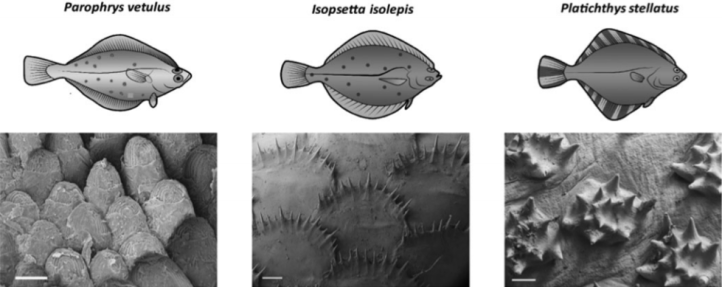Flounder, halibut, and sole are not just fish names prone to puns; they are all species of flatfish (Pleuronectiformes), which have two eyes on one side of their body (eyed side) and no eyes on the other side (blind side). As adults, all species of flatfish spend most of their lives with their blind side against the seafloor, camouflaged into the substrate, waiting to pounce on unsuspecting prey.
However, the seafloor is often covered with jagged rocks, abrasive sand, and pinching crabs with sharp claws. Because of this, Dr. Michael Minicozzi of Northern Arizona University hypothesized that flatfish have tougher scales on their blind side than on their eyed side to better protect them from the substrate. Furthermore, different types of flatfish have different types of scales, which Dr. Minicozzi noticed during a beach seine in the Puget sound. One species in particular, the starry flounder (Platichthys stellatus) had noticeably different scales that were rougher than those of the butter sole (Isopsetta isolepis – and yes, they are as delicious as they sound) and the English sole (Parophrys vetulus). The starry flounder has spiny, discontinuous, tuberculate scales, the butter sole has overlapping, ctenoid scales, and the English sole has embedded, cycloid scales. Do these different scale types offer different levels of protection?
 Scanning electron microscope (SEM) images of the English sole’s (P. vetulus) cycloid scales, the butter sole’s (I. isolepis) ctenoid scales, and the starry flounder’s (P. stellatus) tuberculate scales. (Figure from Minicozzi et al., 2019)
Scanning electron microscope (SEM) images of the English sole’s (P. vetulus) cycloid scales, the butter sole’s (I. isolepis) ctenoid scales, and the starry flounder’s (P. stellatus) tuberculate scales. (Figure from Minicozzi et al., 2019)
In a new paper, Dr. Minicozzi et al. (2019) addressed this question by using apples! He took skin samples from the three flatfish species over a wide size range, from both the eyed and blind sides, and pinned them on apples (to provide a controlled, flesh-like backing to the skin, not to make a delicious snack). The scale-covered skin samples were then slowly poked with a pin, and the force required to puncture was recorded on a Materials Testing System (MTS). The scale dimensions over the size range and between sides and species were also measured and compared to determine if area and/or thickness affect puncture resistance.
Interestingly, there were no differences between the scales on the eyed and blind sides! The scales on both sides have the same dimensions and puncture resistance. When scale types were compared, all three species have the same puncture resistance (when scale thickness was taken into account) and the same scale dimensions, except for scale thickness. However, the scales scale up.
As each species grows, the scales grow thicker, and become more resistant to puncture. Not all scales scale the same, though. While the English sole’s scale thickness increases linearly with body size (isometrically), the butter sole’s scale thickness increases sublinearly, and the starry flounder’s increases supralinearly. That is to say, the butter sole’s scales grow at a slower rate relative to their body growth rate, while the starry flounder’s scales get thicker at a greater rate.
 English sole caught in a beach seine in the Puget sound. (Photo by Noah Bressman)
English sole caught in a beach seine in the Puget sound. (Photo by Noah Bressman)
So, if the different scale types don’t offer different levels of protection from puncture, then what are the functions of the different scale types? According to Dr. Minicozzi, they could offer different levels of crypsis, friction (which affects their ability to hold onto sediment), or protection from other types of mechanical forces, like shearing. Nonetheless, we still have plenty to learn about these really weird fish!
Noah Bressman is a PhD Candidate at Wake Forest University studying fish functional morphology, biomechanics, and behavior, with a special focus on amphibious fishes.You can find more at NoahBressman.wixsite.com/Noah or @NoahwithFish, or contact him at NoahBressman@gmail.com.